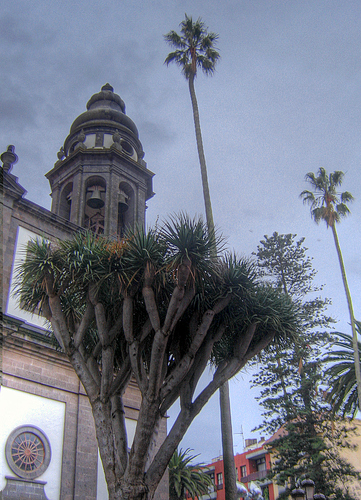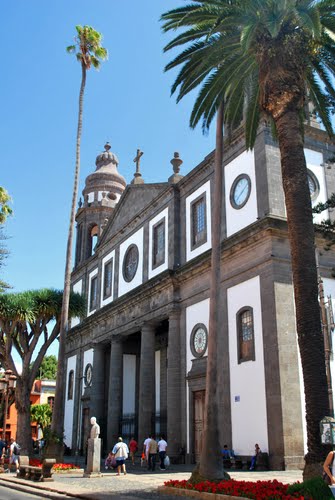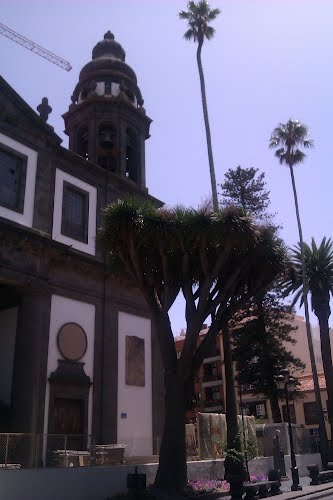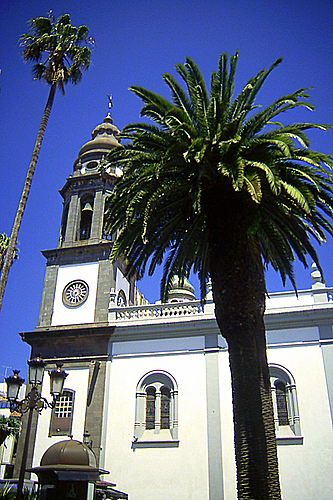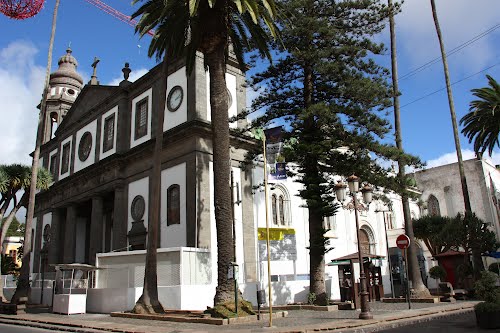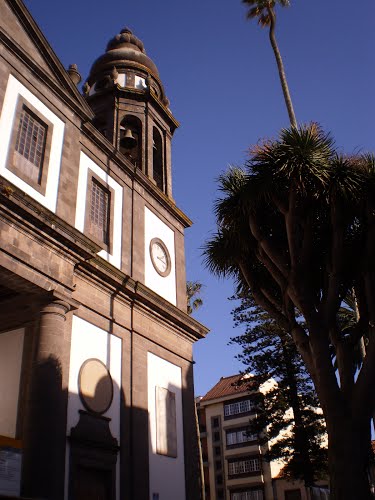The Cathedral of San Cristobal de La Laguna or Catedral de Nuestra Senora de los Remedios is a Catholic cathedral in Tenerife, Spain. Begun in 1904 and completed in 1915, it is dedicated to the Virgin of Los Remedios. It is the mother church of the diocese, which includes the islands of Tenerife, La Palma, La Gomera and El Hierro in the province of Santa Cruz de Tenerife and is therefore where the episcopal seat of the bishop of this diocese, currently occupied by Bishop Bernardo Alvarez Afonso. This is one of the most important churches of the Canary Islands.
The Cathedral of San Cristobal de La Laguna is located in the city of San Cristobal de La Laguna. In the cathedral lie the remains of Alonso Fernandez de Lugo, conqueror of the island and founder of the city. The cathedral is located in the historic center of the city of La Laguna, and was declared a World Heritage Site in 1999 by UNESCO. The cathedral contains elements of several architectural styles including Neoclassical and Neo-Gothic. The most representative elements of the Cathedral of La Laguna are its Neoclassical facade, inspired by the Cathedral of Pamplona, and the dome, which stands out prominently in the city landscape.
History
Primitive temples
In 1511 a hermitage was built on the site of the current building. It was built by order of the conqueror of the island, Alonso Fernandez de Lugo. There are indications that there was a Guanche necropolis. It is also known that the whole valley of Aguere, especially the large lake that was in this place, was a place of pilgrimage for the indigenous people of the island.
This primitive chapel was originally dedicated to the Virgin Mary in her Expectation, which is celebrated every 18 December.
The chapel was replaced in 1515 with a major construction dedicated to the Virgin of Los Remedios in the Mudejar style, to which a tower was added in 1618. It was on 21 April 1515, when the site rose to the level of parish with the name "Santa Maria de los Remedios". The feast day of the Nativity of the Virgin Mary is celebrated on 8 September.
That same year, the Portuguese mason Miguel Alonso built the main chapel, the main arch, the altar, the stands, the tabernacle and the door of the sacristy, all made of stone.
On 7 April 1534, Saint José de Anchieta was baptized in the church. He was born in the city of La Laguna, became a missionary, and later became the founder of the city of Sao Paulo and one of the founders of Rio de Janeiro, both in Brazil. Precisely the cathedral is the diocesan shrine of the saint in the Canary Islands.
In 1752 a new transept was built, the main chapel vestries were widened and spacious dressing rooms were added for the image of the patron saint, the Virgen de los Remedios. Don Domingo de la Guerra, who directed the work and was later Marques de San Andres, extended the main chapel, because he hoped that one day the temple would become the Cathedral of Tenerife.
Cathedral
everal times since the old chapel was converted into a parish in 1515, there were attempts to have it be designated a cathedral, collegiate, or auxiliary cathedral dependent on the Cathedral of Santa Ana of Las Palmas de Gran Canaria, with some of the members of the Canary Cathedral Chapter residing in the Church of Los Remedios. These initial applications were not successful.
In 1783, at the height of the Enlightenment (La Laguna was the center of this movement in the Canary Islands), a request was made for designation as a diocese to be located in the Church of Los Remedios but the request was received with suspicion by members of the Cathedral Chapter and the Bishop of Gran Canaria, and the establishment of an ecclesiastical institution on this island was again rejected.
Finally, on 1 February 1819, a papal bull approved the division of the Roman Catholic Diocese of Canarias in two dioceses. The temple became a cathedral in 1819 by bull of Pope Pius VII, and the new diocese of La Laguna was created. The Diocese of San Cristobal de La Laguna includes the islands of Tenerife, La Palma, La Gomera and El Hierro in the province of Santa Cruz de Tenerife.
In obtaining the title of cathedral and the creation of the Diocese it had an important role priest Cristobal Bencomo y Rodríguez, confessor of King Ferdinand VII of Spain and Titular Archbishop of Heraclea. His tomb is now in the presbytery of the Cathedral of La Laguna, next to the Epistle.
At the time the building was constructed and dedicated as a cathedral, the capital of the island was the city of San Cristobal de La Laguna, which is why the cathedral was built there and not in the current capital of the island. The diocesan headquarters still remains in San Cristóbal de La Laguna. On 5 October 1983, the Cathedral of La Laguna was declared a National Historic-Artistic Monument in Spain.
The cathedral is also a parish and a Marian shrine, as the Virgin of Los Remedios is the patron saint of the Roman Catholic Diocese of San Cristobal de La Laguna. There is some expectation that this church will be declared a minor basilica by the Holy See in the near future.
Restoration 2002–2014
In 2002 the cathedral was closed to worship for a meticulous restoration, with the intention of reopening a few years later. However, due to bureaucratic disagreements, the cathedral remained closed for more than a decade. During the pre-restoration study, it had been discovered that the main dome and vaults were so damaged that the only viable solution was the demolition of these elements and their subsequent reconstruction. The new vaults and domes were built with a new material, polypropylene fiber, making the cathedral the first in the world to use this material. Finally, the doors were reopened on 25 January 2014, to be reopened to worship on 31 January of that year.
To mark the centenary and the reopening of the cathedral, a Jubilee Year was held from 27 April 2014, until 12 April 2015, both dates coinciding with the Divine Mercy Sunday. That Jubilee was decreed by a special mandate of Pope Francis, with the chance of winning the faithful a plenary indulgence.
During the remodeling, which included Cathedral Square in 2014, archaeological remains were discovered underground. Some evidence was unearthed in the rubble that suggested it belonged to the ancient Church of Los Remedios or to structures from the first European settlement in the city.

